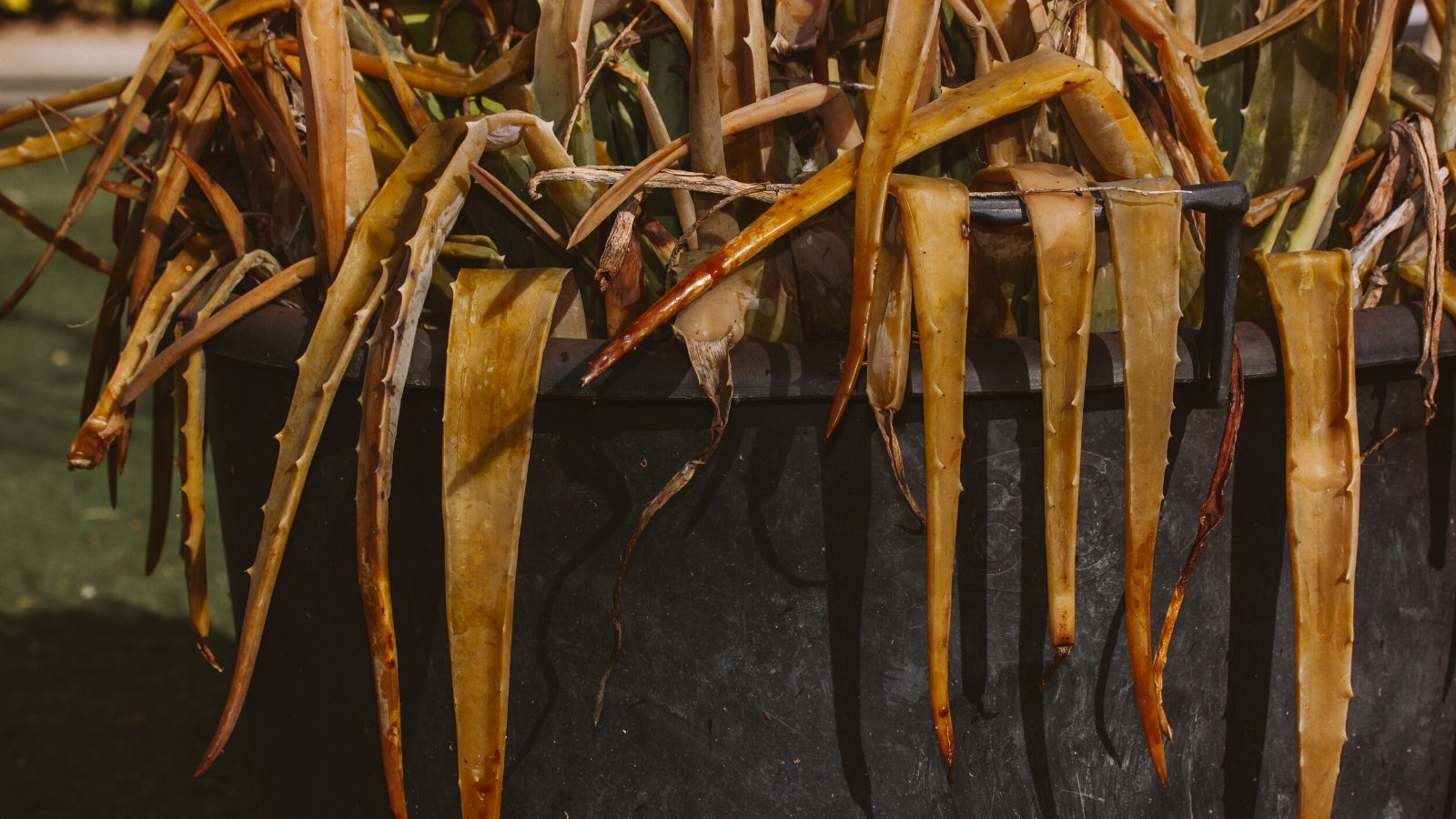[ad_1]
Aloe vera is a perennial succulent native to Africa’s scorching, dry, warmth areas. Its gorgeous leaves, drought resilience, and soothing gel have earned it a spot in windowsills and gardens worldwide.
Although these crops are extensively adaptable and easy to care for, they aren’t proof in opposition to points. Blackening foliage and dying leaves are clear indicators {{that a}} plant is gloomy. Let’s dig into six potential causes for a black, dying aloe plant and the way one can restore them.
Why is My Aloe Turning Black and Dying?
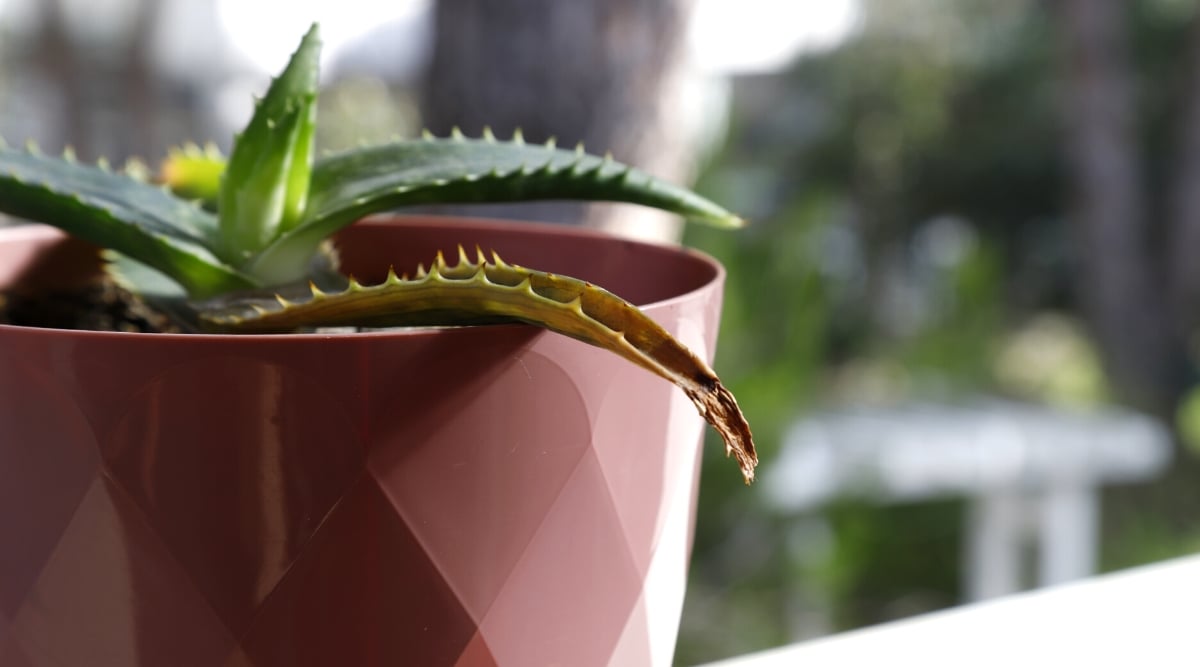

The quickest method to help a dying aloe plant is to remove it gently from its pot and take a look at the roots. Use sanitized pruners to take away rotten, mushy, or fungal-infected components. You’ll be able to too take away ineffective or blackened leaves. Rinse the roots, then refill the container with an extra well-drained soil mixture of vermiculite, pea gravel, and perlite.
Alternatively, purchase a cactus or succulent potting mix. Replant the aloe and place it in an house with sensible, indirect daylight. Wait numerous weeks for the leaves to regenerate. Do not water until the soil has fully dried out.
6 Causes for a Sad Aloe Vera Plant
Even basically essentially the most sturdy aloe vera crops can face factors when their care or ambiance modifications. Blackened leaves or dying foliage are clear indicators of distress. On a regular basis be aware of what your plant is displaying you on account of the seen look provides clues to the inspiration purpose behind the issue.
When diagnosing these indicators, restore one issue at a time and don’t forget that a number of downside can be at play. Your plant would possibly take numerous months or maybe a complete season to recuperate, nevertheless most aloe vera crops can be revitalized with appropriate care.
Overwatering
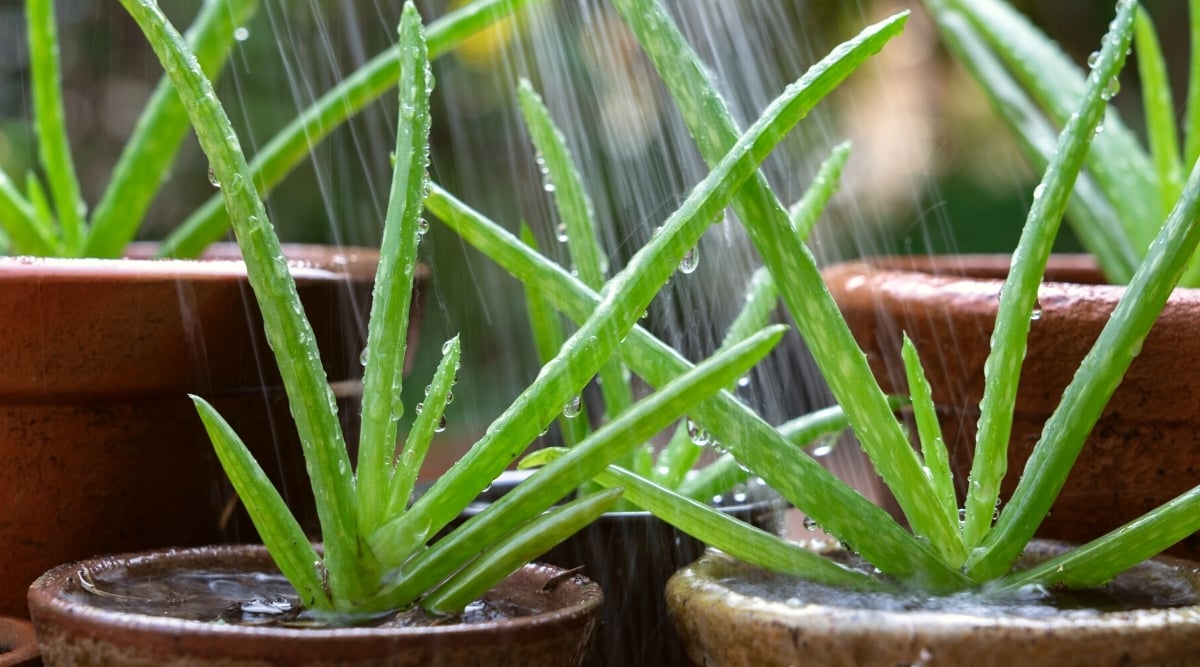

Excessive watering is usually of us’s most common mistake with aloe crops and succulents. Overwatering your aloe ends in suffocated roots that finally rot. This downside is compounded when aloe grows in a pot with poorly drained soil and a moist native climate.
Whereas water is vital for plant survival, these species have tailor-made to prolonged intervals of desert drought. Aloe vera nonetheless enjoys water every couple of weeks to months, counting on circumstances, nevertheless houseplant lovers usually go overboard.
Aloes are naturally arid, drought-resilient crops that retailer moisture of their leaves as a gel. Excessive moisture throughout the soil invites fungi to colonize roots, turning them mushy and black. When root hairs and tissues begin rotting, the plant satirically can not uptake water. Above ground, the leaves begin to yellow and swap brown or black. They’re cut back off from nutritional vitamins and water, making it unimaginable for the leaves to photosynthesize and retain their healthful inexperienced color.
The best solution to Restore It
Aloe vera does biggest when you modify your watering schedule to let the soil fully dry out in between waterings. Steer clear of watering any time the soil feels moist. For individuals who stick your finger throughout the soil and your pores and pores and skin comes out dirty or moist, don’t water. Whenever you’ve acknowledged that the soil is just too moist, chances are you’ll each let it dry out for numerous days to per week or look at further. The issue of overwatering could also be very intently correlated with root rot and poor soil drainage.
When the soil is dry numerous inches down, and the leaves appear turgid and upright, chances are you’ll water as soon as extra. Any time you water aloe, solely pour the watering can until moisture comes out of the underside drainage hole, then stop.
If rising in a container with no drainage hole and catchment tray, transplant the aloe immediately and confirm that the roots haven’t rotted. If rising throughout the ground, you’ll doable should uproot the plant, amend the soil to reinforce drainage, reduce watering, and replant. In extra-rainy climates, it’s normally biggest to maneuver aloes into pots in an house protected in opposition to rainfall.
As quickly because the soil dries out, monitor to see in case your plant perks once more up. If it doesn’t, switch on to have a look at the indicators beneath. You’ll take away blackened or brown leaves to encourage new growth, nevertheless steer clear of defoliating the plant on account of it may nonetheless need healthful leaves to regenerate.
Root Rot
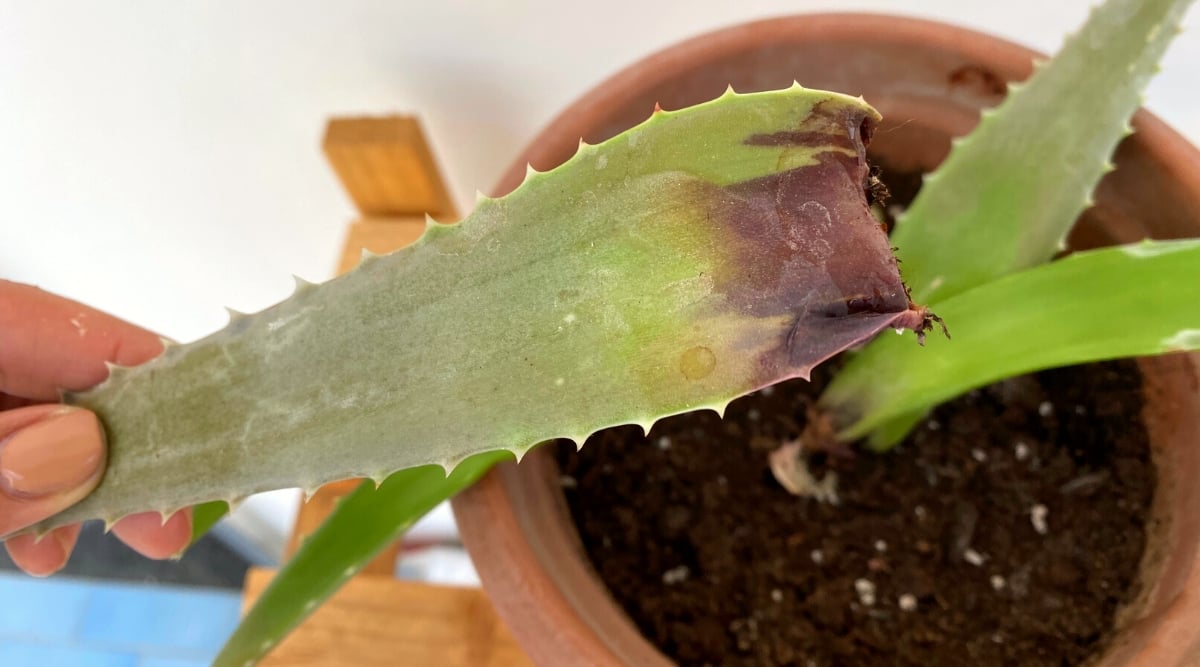

Root rot nearly always occurs together with overwatering and poorly drained soil. It is notably frequent in succulents and cacti. Root rot is attributable to pathogenic fungi that colonize the aloe’s roots and suffocate them. The roots grow to be soggy, mushy, and black, finally dying off. The rotten roots cannot uptake minerals or water.
Typically, chances are you’ll odor a foul odor from the soil ground when the roots are rotting. Totally different events, you’ll solely see the above-ground indicators of yellow, brown, or blackened leaves that wilt and die regardless of how quite a bit water is present. The one method to know that the roots are rotten is to dig up the plant and take a look at the inspiration system.
The best solution to Restore It
Most crops can be saved from root rot if some healthful root tissue stays. First, fastidiously take away the aloe from its container or dig it up from the underside. Flip the plant on its aspect, taking care to not break off any leaves. Brush away any soil and intently look at the roots.
Healthful aloe roots appear thick, intertwining, and whitish-yellow or orangish-brown. The texture is company however pliable. Rotten roots look darkish brown or black and slimy or mushy. Often, the rotten areas will merely fall off when handled.
Use sterilized pruners or shears to cut back away the rotten areas. Go away the plant out in a single day on a towel in a darkish, dry house so the cut back components of the roots can variety callouses. It’s going to help cease re-infection. Eliminate all contaminated plant elements and eliminate the sooner soil as properly. Wash out the container, let it dry, then refill it with a current, well-drained succulent soil combine. Make a spot within the midst of the soil and place the plant once more inside, then backfill. Steer clear of watering for per week or so until the roots can toughen once more up and start regrowing.
If remediating an aloe vera plant rising throughout the ground, fully amend the soil with the principles beneath regarding soil drainage. As quickly because the rotten root elements are eradicated and the soil drainage is improved, chances are you’ll plant it once more within the equivalent location and patiently stay up for it to recuperate.
You will know aloe has recovered from root rot when youthful new leaves emerge and current leaves perk once more up or flip inexperienced. Nonetheless, if any leaves are absolutely blackened or ineffective, they will not regenerate and must be eradicated.
Poor Soil Drainage
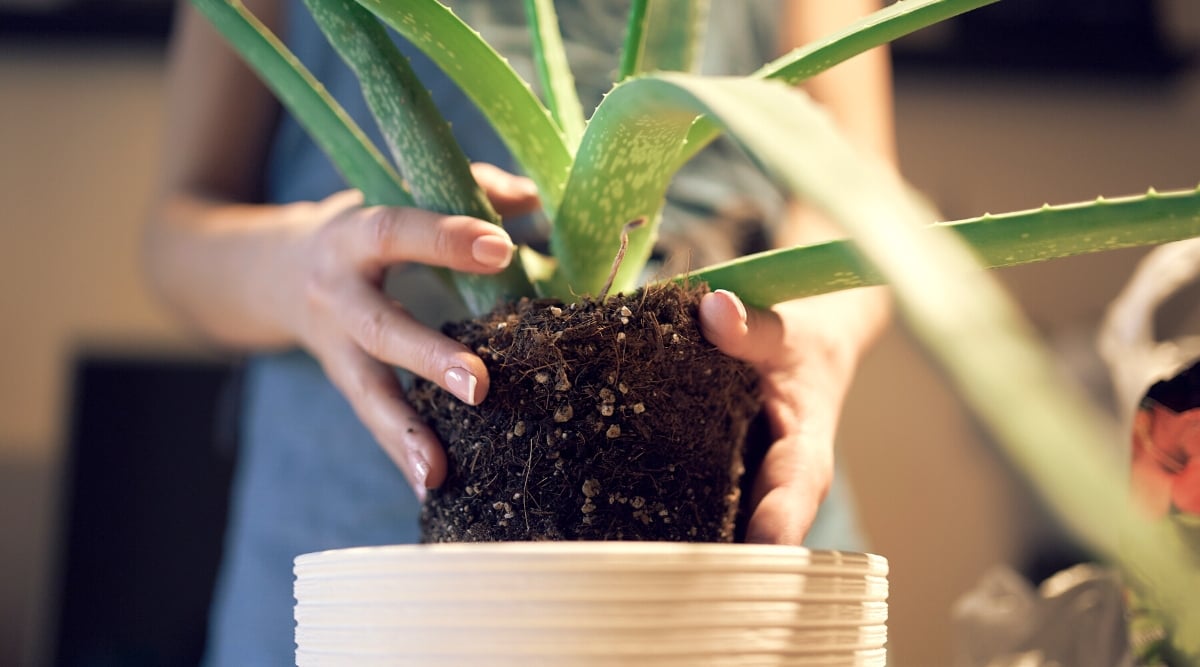

Overwatering, root rot, and poor soil drainage could possibly be a disastrous triple whammy for aloe crops. Often, when one among these factors causes indicators, all three of the problems are at play. Any time you uncover blackened, dying leaves, it’s advisable to repot or transplant them into better-drained soil.
Aloe crops need very porous, fast-draining soil that strikes water by in a short while. They wrestle in heavy clay soils and don’t need rich compost that holds onto moisture. The simplest soil for aloe vera is well-drained, sandy, or gravelly in texture. Succulent or cacti potting blends with perlite and vermiculite help enhance drainage.
The best solution to Restore It
Use your arms or a shovel to softly uproot the aloe by digging throughout the plant’s perimeter and lifting it out of the container or yard mattress. Put collectively the model new soil after analyzing the roots and checking for root rot.
The best method to ensure appropriate drainage is to purchase a pre-blended cactus or succulent combine. In the event you want to make your particular person or amend native soil, incorporate a whole lot of sand, high-quality gravel, crushed rock, and perlite or vermiculite.
Sooner than replanting the aloe, chances are you’ll check out the soil for drainage by placing a handful in a container and pouring water over it. If the water swimming swimming pools up on the ground and takes a while to empty, it’s a fundamental sign that it needs further aeration. Heavy concentrations of clay can impede water circulation and make it accumulate on the ground. If the water rushes by the soil shortly, it is good to go! Change your aloe and make sure it is planted on the same diploma as a result of it was sooner than.
Chilly Publicity
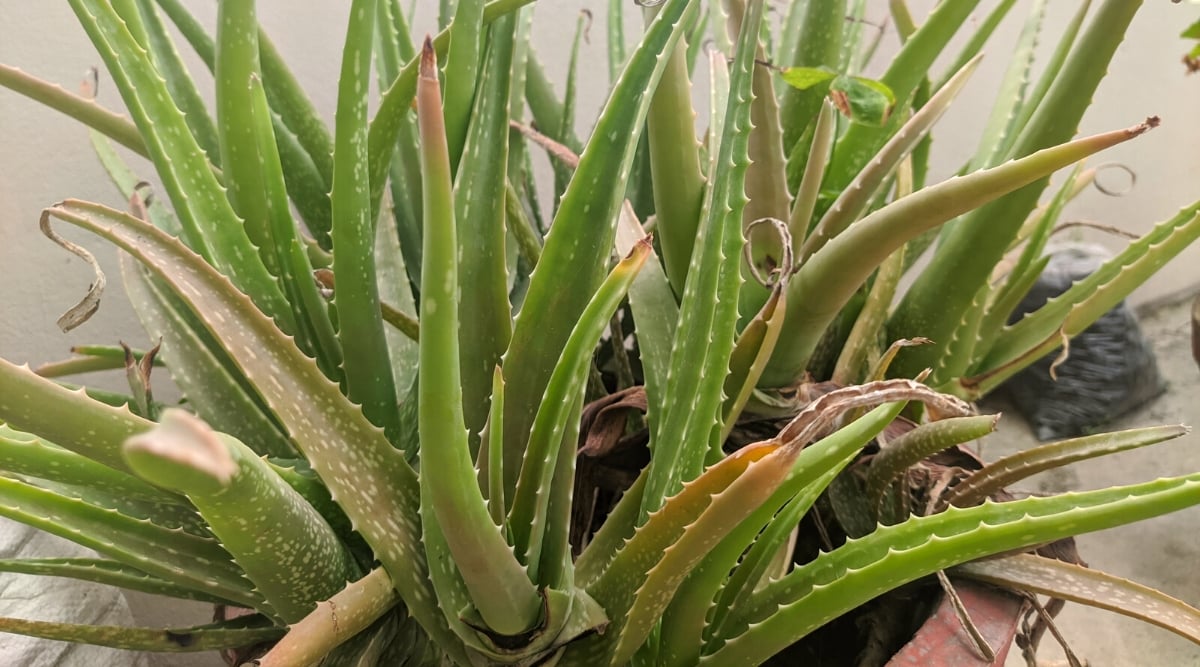

Aloe crops thrive in temperatures above 60°F. These warmth native climate crops would possibly flip yellow or brown when uncovered to chilly temperatures beneath 40-55°F. Some mature, healthful crops in warmth microclimate rock gardens can resist the colder range of the spectrum, nevertheless youthful or damaged crops are basically essentially the most vulnerable to the chilly.
Chilly publicity normally occurs when houseplants are left exterior or subtropical areas receive shocking chilly fronts. This temperature sensitivity is the primary motive why outdoors aloe vera is barely advisable in zones 10-13. To develop aloe open air in northern climates, look for species like spiral aloe (Aloe polyphylla) or coral aloe (Aloe striata) that are chilly hardy.
The best solution to Restore It
After chilly publicity, immediately switch the plant to a warmer location. Counting on how harsh the chilly was, some leaves would possibly flip delicate, translucent, or light. On this case, they must be eradicated. However once they solely appear yellow or brown, they’re able to recuperate as quickly as in a warmer home. Maintain your aloe indoors in an house with sensible, indirect daylight.
Photo voltaic Scald
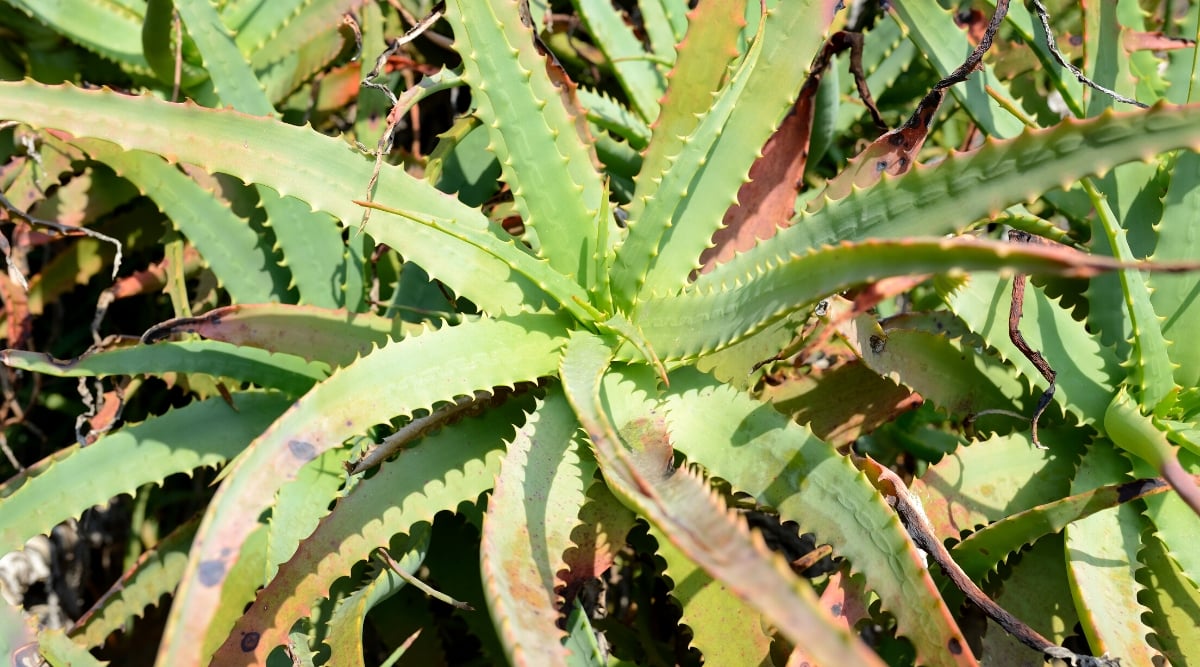

Aloe vera is a desert plant accustomed to sensible, harsh daylight. Nonetheless, houseplants are typically accustomed to a lot much less intense lighting circumstances. The leaves can grow to be scorched if aloe is the entire sudden moved from a windowsill exterior onto a south-facing patio within the summertime.
Shifting from an house with partial shade or indirect delicate to an space with intense direct photo voltaic shocks the plant. With out sufficient time to acclimate, the leaves would possibly shortly flip yellow, orange, brown, or black and begin to wilt. Typically, they deal with a reddish hue after being burnt. Whereas crops can recuperate, it takes numerous time and endurance for them to regrow.
The best solution to Restore It
First, switch your aloe to a shadier spot as shortly as attainable. Go away the photo voltaic burnt leaves in place to see within the occasion that they revitalize. Current a little bit of additional water and wait numerous weeks for it to regrow. It would need further water than extraordinary, but it surely absolutely’s very important to not overwater. Protect the leaves from direct daylight whereas they recuperate, nevertheless assure they nonetheless get indirect dappled delicate by a window or {{a partially}} shaded yard house.
Under no circumstances switch an aloe plant into drastically completely completely different lighting circumstances with out acclimating it. In the event you want to switch a houseplant open air for the summer time season, usually introduce it to further delicate over numerous weeks.
As an illustration, chances are you’ll first switch it from the middle of the room to some toes from a south-facing window. Wait numerous days, after which switch it nearer to the window. As quickly because the leaves have adjusted and developed their pure photo voltaic security, switch the plant to the patio, the place it is partially shielded from the afternoon photo voltaic.
Take into account, crops don’t have legs, they usually do not switch in nature. In case you’re transplanting open air or transferring aloe from one place to a unique, always obtain this gently and usually.
Underwatering
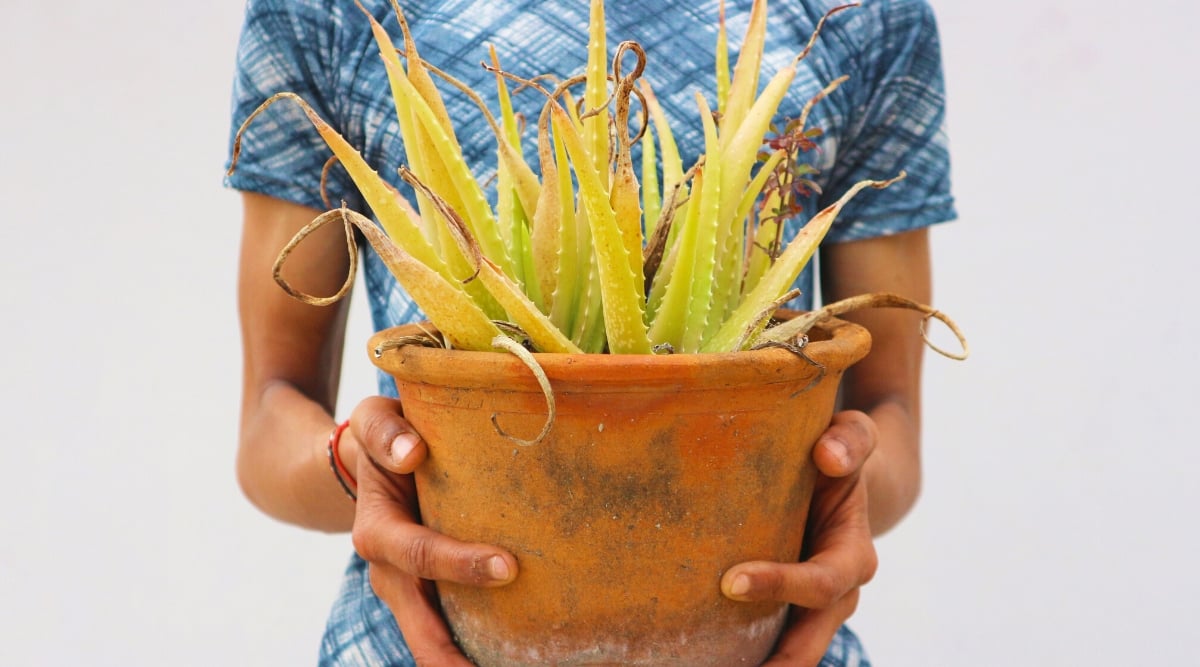

Whereas uncommon, aloe crops can usually flip black or brown due to underwatering. This doable solely happens in container crops left for numerous months with none care. Underwatered crops appear dry, shriveled, and brittle. The soil could be dusty and chalky, with no moisture the least bit.
The best solution to Restore It
Confirm the soil moisture near your aloe vera every 1-2 weeks. Smaller pots need water further incessantly than big containers or in-ground crops. Stick your finger throughout the soil to confirm the moisture diploma numerous inches down. When the soil fully dries, it’s time to water as soon as extra.
Water aloe crops deeply nevertheless often. An enormous flush of water mimics the flash flooding and monsoons of the desert. Pour water until it flows freely out of the underside drainage hole of a container, then stop. Confirm the plant in numerous days to see if it has perked once more up. Steer clear of bombarding it with moisture until you understand it has absorbed the added water.
Final Concepts
The most typical motive for a black or dying aloe plant is root rot due to overwatering and poorly draining soil. These arid-climate crops ought to solely be watered when the soil dries out. The water ought to empty by the soil profile shortly. Vegetation may additionally present associated indicators if uncovered to excessive chilly or a harsh change in daylight publicity.
Uproot the plant, take a look at the roots, transplant to better-drained soil, and switch to protected warmth circumstances while you patiently stay up for the leaves to regenerate.
[ad_2]
Provide hyperlink
